A recognized sedge weaving artisan (
wanchojang), Hur Sung-ja boldly applies modern design to the age-old craft. Expanding the range of uses and formal features of conventional sedge products, her art s open up a new horizon for traditional crafts.
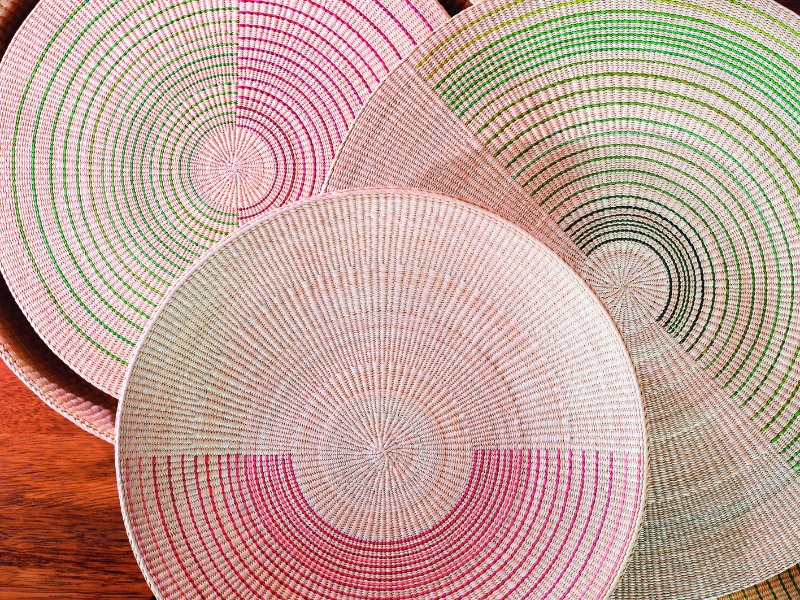
Circular sitting mats are one of the basic products of weaving with sedge, a plant found in rice paddies and swampy areas.
In the past, Koreans in agricultural communities would craft daily household items using plants and straw easily obtained in their surroundings. Making craft items with sedge (wancho or wangol in Korean) was a profitable sideline for farmers during their long winter break. Floor mats woven with sedge were popular, as they offered a blessed release from the humid heat of summer, while their colorful patterns brightened up interior spaces.
The indigenous handicraft has a long history. According to History of the Three Kingdoms (Samguk sagi, 1145), the courts of the ancient Three Kingdoms of Korea had sedge weaving workshops to produce craftworks for the royal family, and people of higher social standing would use sedge mats as drapes for their carriages. During the Goryeo Dynasty, along with ginseng products, sedge mats woven with exquisite floral patterns (hwamunseok) were an important trade item. Illustrated Account of Goryeo (Gaoli tujing, 1123), written by the Chinese envoy Xu Jing of the Song Dynasty, contains detailed information on the flower-patterned mats, indicating that Koreans had by that time perfected the elaborate techniques for weaving them.
Published in the early Joseon era, Geography Section of the Annals of King Sejong (Sejong sillok jiriji, 1454) mentions skinned sedge stems as a regional specialty sent to the royal palace from a locality belonging to today’s Ganghwa, an island county west of Gimpo. From early on, the appropriate soil and climate of this region made it an optimal place for growing sedge. Sedge mats were produced in almost every household on Gyodong Island, Ganghwa County, but the craft declined rapidly when cheap alternatives started to be imported in the 1980s. Currently, only a handful of artisans continue the legacy of traditional sedge-mat weaving.
Ultimate Skills and Concentration
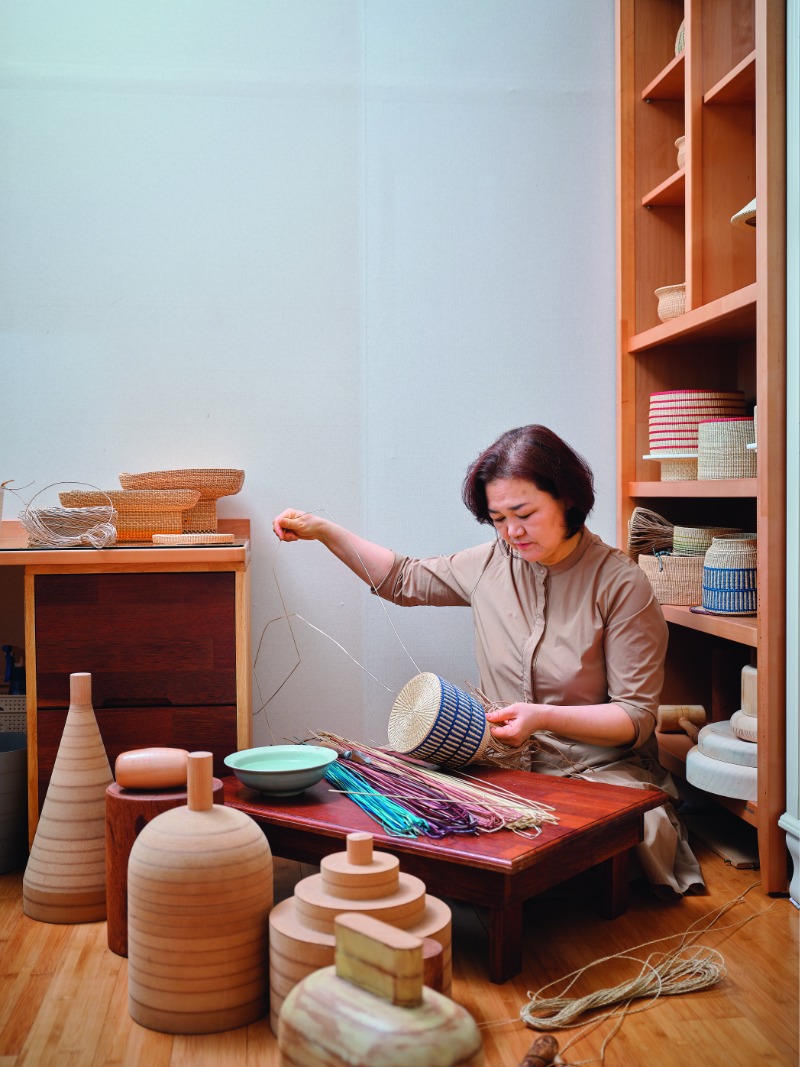
Hur Sung-ja did not start her professional career as a traditional artisan until she was more than 30 years old. Her work is acclaimed for its modern design applied with original expressive techniques.
The sedge weaving process consists largely of two stages: the preparation of sedge stems and the actual weaving. Sedge plants are harvested in July and August and then processed in winter. The stems are soaked in water and dried repeatedly until the skin is soft and durable, tinged off-white and bleached of the bluish hue particular to the plant. After this treatment, the stems to be used tocolorful patterns are boiled in water mixed with dyes and then dried again. The prepared sedge stems are sorted by thickness and stored for use.
After the stems are prepared, the actual weaving begins, either using tools or done entirely by hand. Large mats like hwamunseok are woven using tools — a weaving loom with two rows of s, each with a weight attached, hanging from either side of the upper beam of the loom. The prepared sedge threads are placed on top of the beam one at a time, and each row of weighted s is crossed over to the other side of the beam to secure the thread in place.
Weaving smaller articles like sitting mats, baskets, and containers, which is mostly done by hand, requires advanced techniques and delicate skills. The first step is to prepare warp threads with two strips of thinly split sedge stems twisted clockwise. The weft threads are not twisted but should be of differing thickness to shape the product and weave patterns into it.
To make articles such as cases and baskets, a small circular mat is woven first and then the sides are raised along the circumference. The sides are all made in the same way, but it takes skill and experience to weave them so that they are properly curved. It is important to maintain the right tension to evenly weave the threads while using wefts of various sizes. A craft requiring great finesse and concentration, sedge weaving is a designated National Intangible Cultural Heritage, and qualified practitioners are recognized as master artisans.
Interested, Motivated, and Talented
Hur Sung-ja was born and raised on Ganghwa Island. Sedge was found all over the island, and as a child she played with it when her parents were weaving hwamunseok as a side job, like any other family around them. As she watched her mother weaving sedge mats, she also learned some simple techniques. But for the time, that was that. It was only in 2005, when she was well into her 30s and married with children, that she finally began to take up the traditional craft in earnest.
“I started to work at the Hwamunseok Culture Center when it opened in my neighborhood,” Hur said. “Earlier, I’d thought the craft was all about weaving floor and sitting mats, but working there, I learned more about its different applications for household items. I had a great time learning from artisans in the classes offered by the Culture Center. I was so absorbed in the craft that even after work, I would start weaving as soon as my children went to bed.”
Doing what she loved for a living, her skills improved very quickly. Hur submitted her works to various arts and crafts contests, including the 2009 Korea – Japan Joint Basketry Exhibition held at the Hanbyeogwon Art Museum in Seoul. When she was awarded the Best Prize in the Ganghwa Handicrafts Contest in 2011, she started to gain recognition as a sedge weaving artisan. In the same year, she won the Grand Prize in the Incheon Crafts Competition, and the Small and Medium Business Administration Prize in the Korea Crafts Competition.
“I was lucky to win the prizes. I submitted my works to have them evaluated by experts, although I’d made them for my enjoyment. Even so, prizes can encourage and motivate you to work harder, can’t they?” she said.
While doing what she loves, Hur also gathered accomplishments. She became a National Intangible Cultural Heritage scholarship trainee in 2012 and then a certified trainee in 2017. Shortly afterward, she quit her job at the Culture Center and devoted herself entirely to the art of sedge weaving.
“I’m the youngest of the certified trainees. There are highly experienced elders who have worked with this art for a long time, but I want to try something new. This is an age-old tradition, but that doesn’t mean I have to use traditional patterns. So I’ve looked for inspiration in other fields of arts and crafts, reading books and going to exhibitions,” she said.
Hur has tried to bring modern sensibilities to her work by limiting decorative features and adopting the patterns of straight lines and lattices that now characterize her style. The bookshelf in her workshop is packed with design books, giving a glimpse into her efforts.
Between Handicraft and Art
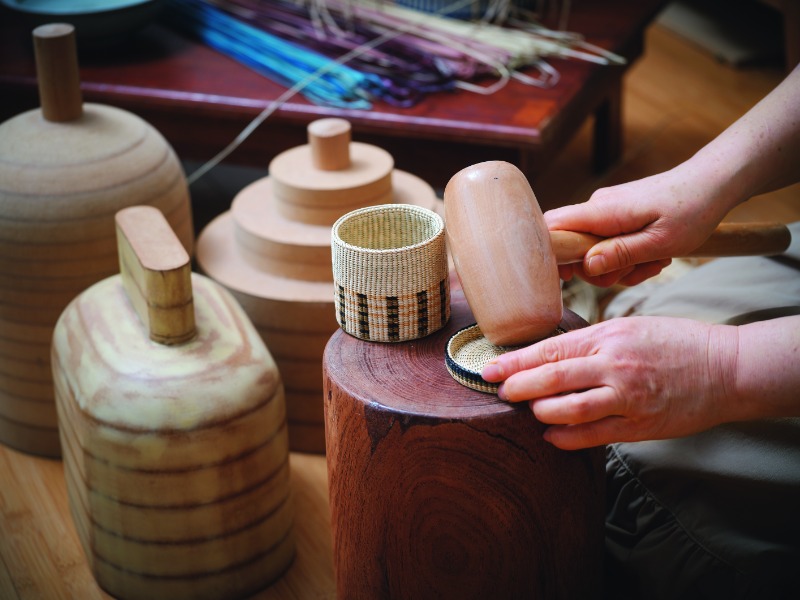
As a finishing touch, Hur Sung-ja strikes the inside of the woven case with a wooden hammer toan even surface.
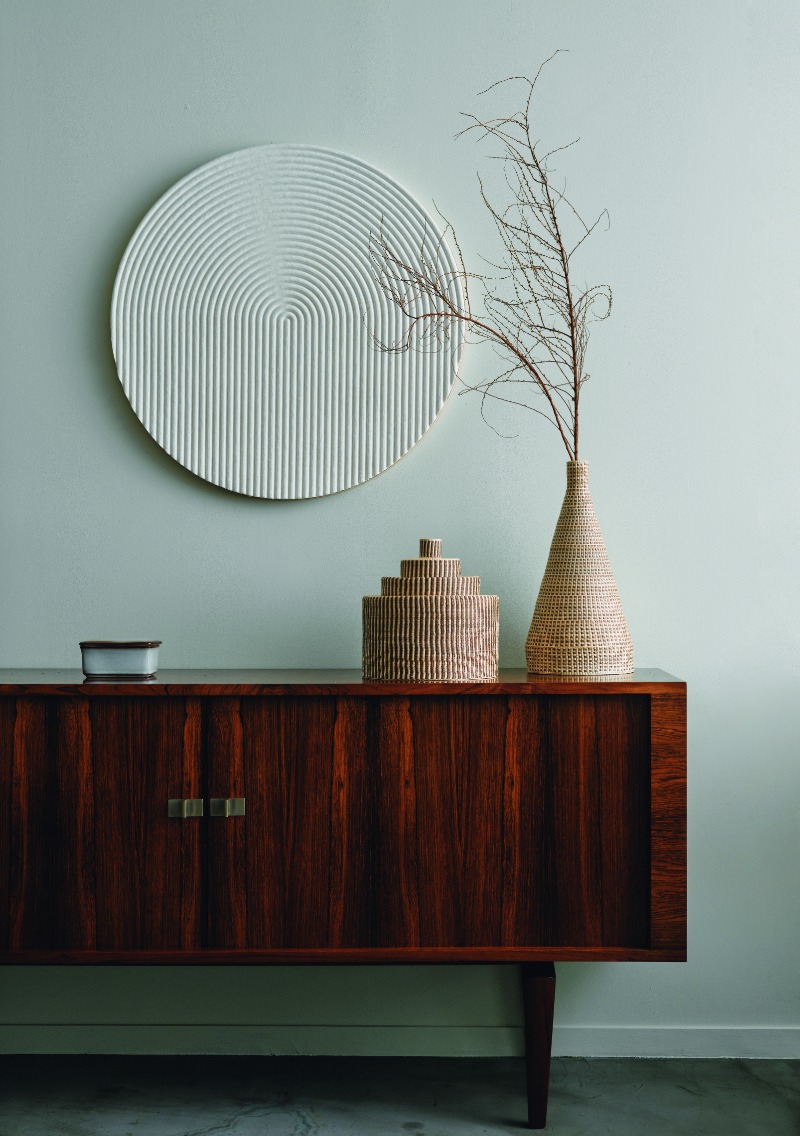
Hur Sung-ja’s year-long collaboration with designers Cho Kyu-hyung and Choi Jung-you, operators of Studio Word, enabled her to stretch traditional forms tos of varied shapes.
Courtesy of Studio Word
“The Certification System for Traditional Crafts is a government project to support certified trainees of National Intangible Cultural Heritage. In 2020, I applied for support with my floral sitting mat. Cho Kyu-hyung and Choi Jung-you, the designers who were the judges as well as advisors of the YÉOL Korean Heritage Preservation Society, saw my work and proposed a collaboration. This turned out to be the turning point in my work, enabling me to weave sedge into shapes that had been impossible towith conventional techniques alone,” Hur said.
Adopting wooden models, she was able to produce s of varied shapes, no longer limited to weaving flat mats and cylinders. The products served a wider range of functions, which had always been one of her goals. Opening up new possibilities in tradition, Hur was soon recognized in the craft scene and was selected as YÉOL Artisan of the Year in 2021.
While the collaboration project enriched her creativity and philosophy regarding her craft, the Korean Crafts Exhibition of the Milan Design Week 2022 was a chance to make her work more widely known. In celebration of the 10th anniversary of the Korean Crafts Exhibition, a special event was held where Italian designers collaborated with Korean artisans. Hur worked with the Italian designer Francesco Faccin to present a set of highly acclaimed works using the sedge weaving craft, including anusing the gat, a traditional horsehair hat, as a motif, as well as chairs and lampshades. Hur herself called it “a brilliant achievement” for an artisan with a relatively short career.
“In fact, I’d rather not be called an ‘artisan’ because I’m not experienced enough. I have the feeling that an artisan is someone who has mastered their skills after years of long, painful perseverance. On the contrary, I’ve been really enjoying myself doing this work, just as much now as I did twenty years ago. You can’t keep doing everything by yourself from beginning to end if you don’t enjoy the work. That’s why I want to be called a craftsperson rather than an artisan.”
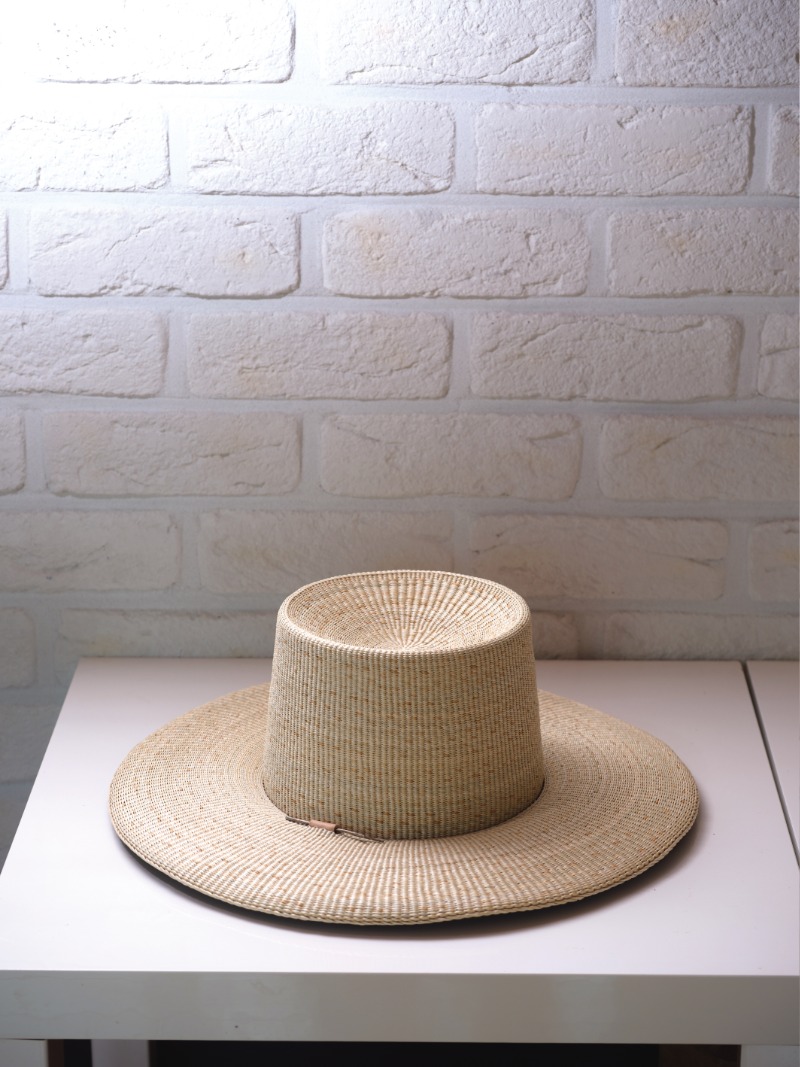
Produced in collaboration with the Italian designer Francesco Faccin, themodeled after the gat, a traditional horsehair hat, was showcased at the Korean Crafts Exhibition of the Milan Design Week 2022.